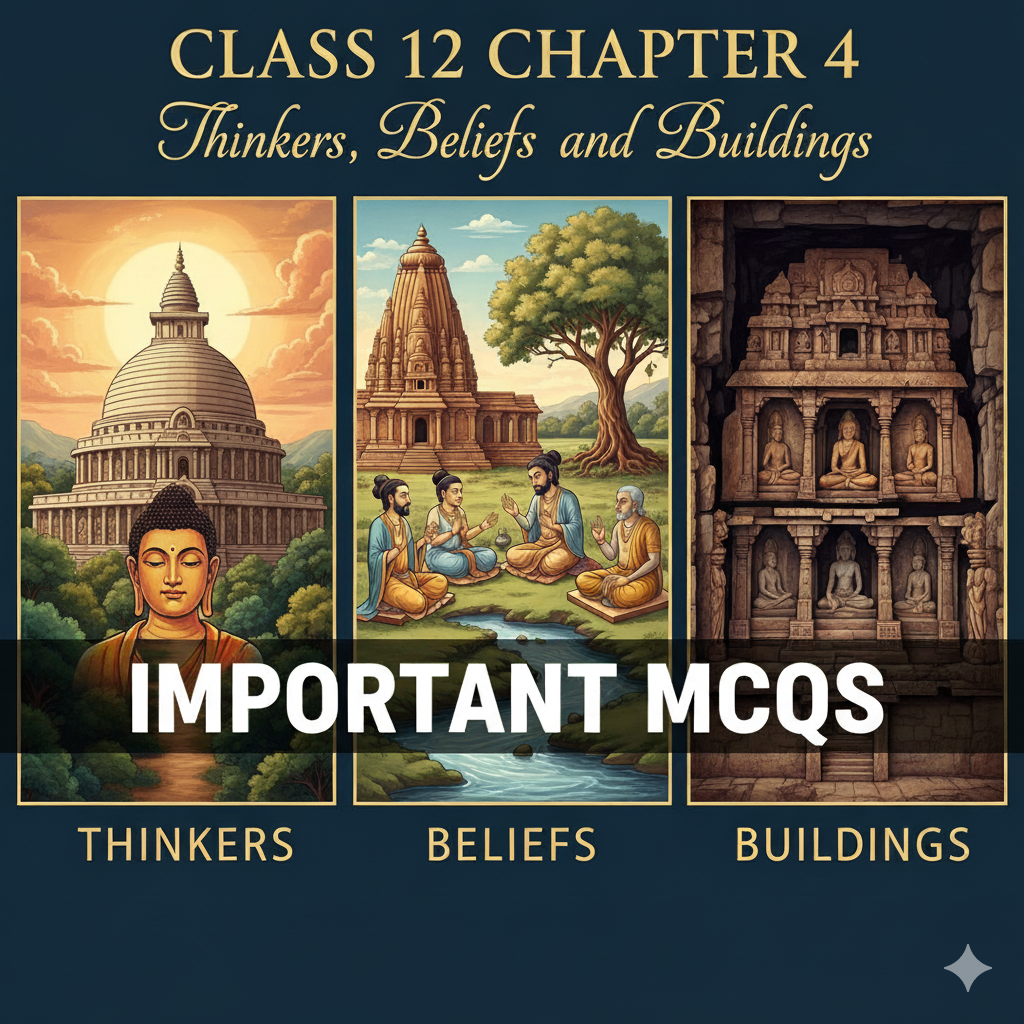1. Which of the following consist of hymns in praise of the variety of deities, especially Agni, Indra and Soma?
(a) Sutta Pitaka
(b) Rig Veda
(c) Sam Veda
(d) Yajur Veda
Answer: (b) Rig Veda
Explanation: The Rigveda is the oldest of the Vedas and is primarily a collection of hymns (ṛc) addressed to Vedic deities such as Agni (fire), Indra (war/royal deity) and Soma (sacral plant / deity). Its core purpose was ritual praise and invocation—composed as poetic hymns to be recited in sacrificial rites—so it is the correct choice. The other Vedas (Yajur, Sāma, Atharva) have different emphases (sacrificial formulas, chants/melodies, and incantations respectively).
2. Which one of the following is the correct pair?
List I ———————- List II
(Time Period)—-(Major Religious Developments)
(a) 1500–1000 BCE — Later Vedic Tradition
(b) 6th Century BCE — First Stupas
(c) 2nd Century BCE — Early Upanishads
(d) 3rd Century CE — Earliest Temples
Answer: (d) 3rd Century CE – Earliest Temples
Explanation: The earliest permanent stone temples (in the form of free-standing shrines rather than rock-cut caves) begin to appear in the early centuries of the Common Era; by the 3rd century CE we see a growing trend of structural temples in parts of India. Options (a) and (c) mix periods and developments incorrectly (Later Vedic tradition is associated more with 1000–600 BCE; the early Upaniṣads are earlier than 2nd century BCE). Option (b) is also misleading—stupas (burial/memorial mounds) appear earlier than the 6th century BCE in some forms; the consolidation and monumental stupa-building is associated with later Mauryan and post-Mauryan periods.
3. Which one of the following aspects describes the meaning of Tirthankaras in Jainism?
(a) Supreme Being who is an incarnation of God.
(b) Those who guide men and women across the river of existence.
(c) Those who follow the part of Vedanta- asterism.
(d) Those who know the ultimate truth and dharma.
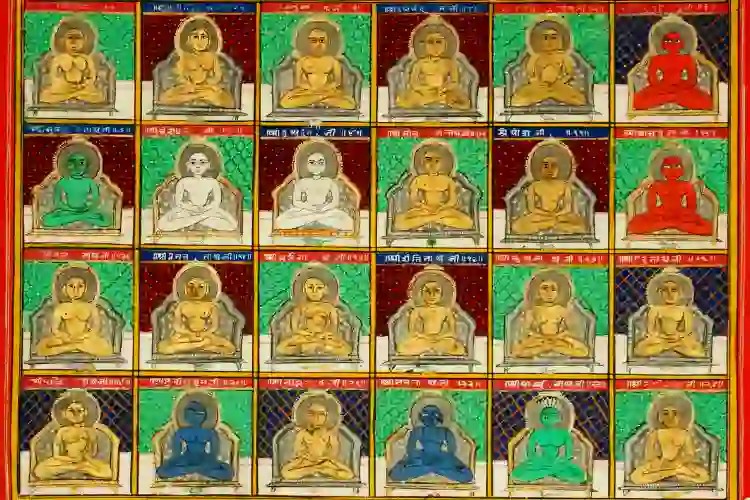
Answer: (b) Those who guide men and women across the river of existence.
Explanation: The Sanskrit term tīrthaṃkara literally means “ford-maker” (one who creates a ford or crossing). In Jain thought Tirthankaras are spiritual teachers who establish a path across the ocean of saṃsāra (worldly existence), helping souls to cross to liberation. Option (d) is close (they do know ultimate truth), but the conventional, precise meaning emphasises the “bridge/ford” metaphor — hence (b) is the classical definition.
4. Consider these two statements about Buddhism:
I. The two major sects of Buddhism are Mahāyāna and Hīnayāna.
II. Buddhism did not believe in the existence of the soul.
Choose the right answer:
(a) Only I
(b) Only II
(c) Both I and II
(d) Neither I nor II
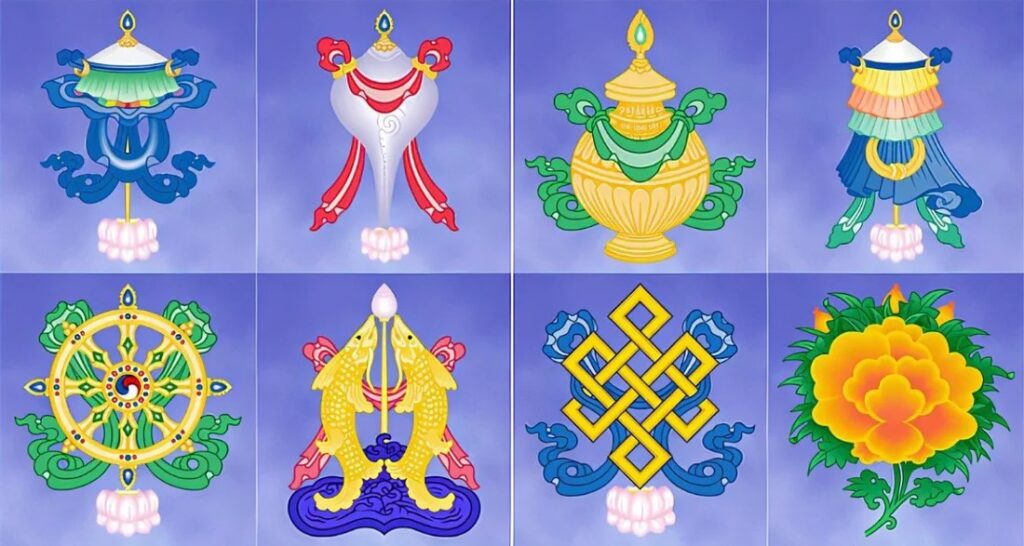
Answer: (c) Both I and II
Explanation: (I) In common parlance classic divisions are Mahāyāna and what was called Hīnayāna (a term now avoided as pejorative; some use “Theravāda” for the surviving early school). (II) A central Buddhist doctrine is anattā (Pali) / anātman (Sanskrit) — the denial of a permanent, unchanging soul; persons are understood as aggregates (skandhas) in flux. Thus both statements reflect traditional descriptions (with the caveat that “Hīnayāna” is polemical historically).
5. ‘Oh how did I make it’ was the statement of the chief sculptor after he completed the making of which temple?
(a) Ellora
(b) Ajanta
(c) Barabar
(d) Mahabalipuram
Answer: (a) Ellora
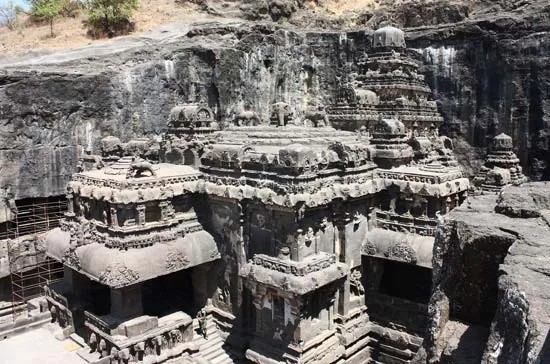
Explanation: Ellora’s Kailāśa temple (Kailasnath) is a monumental monolithic excavation carved downward from living rock. The scale and artistry evoked astonishment in later accounts, and the anecdotal exclamation attributed to the chief sculptor reflects the wonder at accomplishing such an extraordinary feat—carving an entire multi-storeyed complex from a single rock mass. Ellora stands out among Indian rock-cut temples for this audacity.
6. Who among the following was the last Tirthankara, according to Jainism?
(a) Ajita Kesakam Balin
(b) Mahavira
(c) Rishabhdev
(d) Parshvnath
Answer: (b) Mahavira
Explanation: In Jain tradition Mahāvīra (traditionally dated to the 6th century BCE) is regarded as the 24th and last Tīrthaṅkara of the current cosmic era. He systematised and rejuvenated the Jain sangha and teachings that form the basis of the present Jain community’s canonical account.
7. Which of the following is the main source through which we come to know about Buddha and his teachings?
(a) Rock edicts
(b) Monuments
(c) Libraries
(d) Hagiography
Answer: (a) Rock edicts
Explanation: The rock edicts (especially Ashokan edicts) are key early epigraphic sources that mention Buddhist ideas and the patronage of Buddhism by rulers. They provide contemporary, non-literary testimony about moral injunctions (dharma), the spread of Buddhism, and royal support. While hagiographies and later texts are important, rock edicts are primary archaeological documents offering direct historical evidence.
Note: Many of the canonical discourses are preserved in texts (like Pali Suttas) and in later chronicles — but as a material source for the broader historical reception and royal patronage, rock edicts are singled out here.
8. Who among the following provided money for the preservation of the Sanchi Stupa?
(a) John Marshall
(b) Begums of Bhopal
(c) Bahadurshah
(d) Britishers
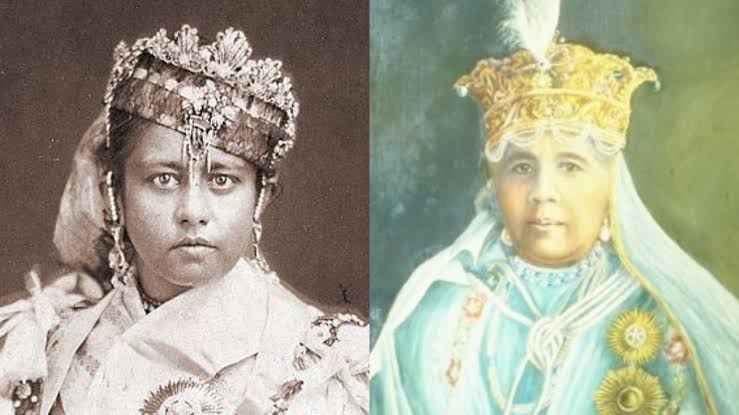
Answer: (b) Begums of Bhopal
Explanation: The Begums of Bhopal (Muslim female rulers of the princely state of Bhopal in the 19th–early 20th centuries) are historically credited with aiding preservation and restoration of many ancient monuments, including contributions toward Sanchi’s upkeep. John Marshall (choice a) later wrote on Sanchi and supervised excavations but the philanthropic patronage in earlier times is attributed to regional rulers such as the Begum.
9. Which of the following is a true statement about fate of Sanchi Stupa?
(a) It was discovered in the year 1818.
(b) Many pieces of sculptures were used by the British and their administration in London.
(c) Many pieces of sculptures were used to decorate the garden.
(d) It was an insignificant little mound and was totally denuded of its formal glory.
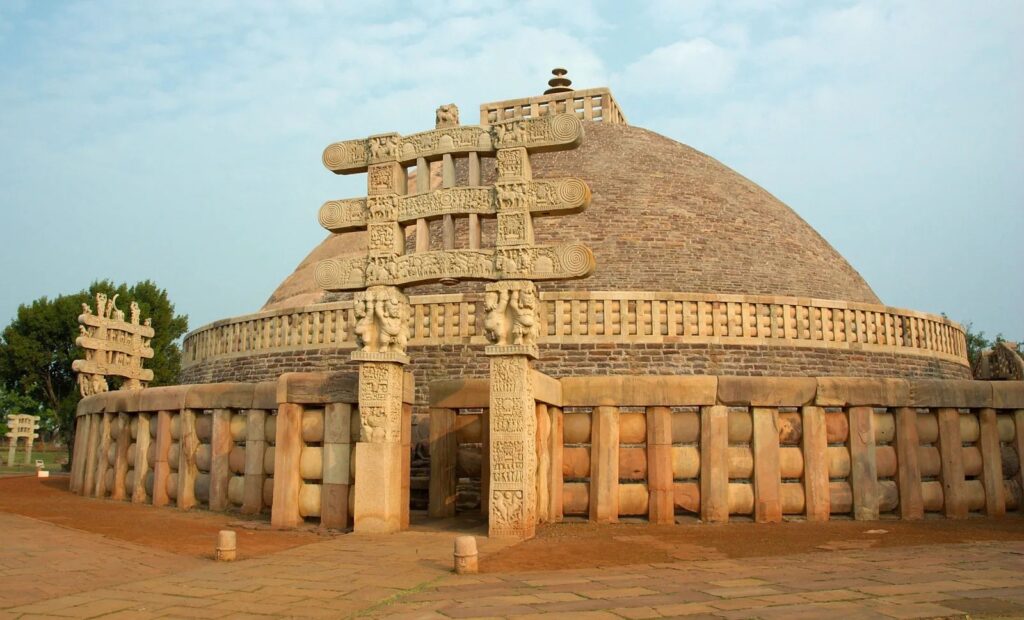
Answer: (a) It was discovered in the year 1818.
Explanation: Sanchi’s rediscovery to European scholars is commonly placed in the early 19th century (around 1818–1820 period) when officers and antiquarians in British India recorded these mounds and gateways. While other statements mention outcomes (sculptures removed etc.), the direct, accepted fact here is the date of rediscovery; later excavations by Marshall and others followed in the early 20th century.
10. After Buddhism reached Asia, pilgrims travelled to India in search of Buddhist text from
(a) China
(b) Burma
(c) West Asia
(d) Tibet
Answer: (a) China
Explanation: Chinese pilgrims (notably Fa-xian, Xuanzang (Hsüan-tsang), and Yijing/I-Ching) travelled to India to collect Buddhist texts and study at Indian monasteries. Their journeys (4th–7th centuries CE and later) are among the best documented pilgrimages and they played a major role in transmitting Buddhist texts and practices back to East Asia.
11. Who among the following was the avatar of Vishnu whose statue is found in Aihole (Karnataka) rescuing the Earth Goddess?
(a) Parashurama
(b) Kumra
(c) Varāha
(d) None of these
Answer: (c) Varāha
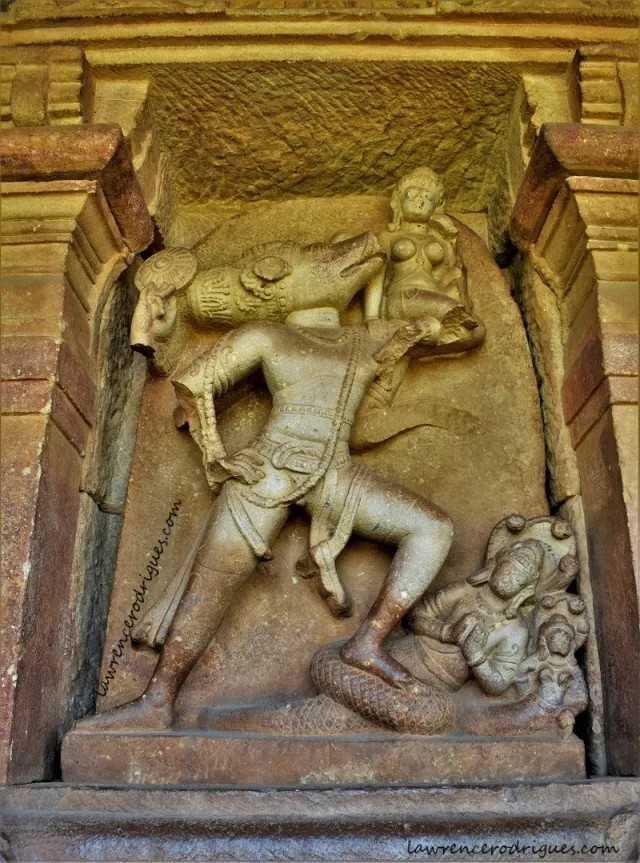
Explanation: The Varāha avatāra of Viṣṇu—boar incarnation—rescues Bhūmi (the Earth) from the cosmic ocean. Sculptural depictions of Varāha carrying the Earth goddess are common in temple iconography; the Aihole relief is one such example where Varāha’s rescue motif is represented.
12. Which book among the following includes rules and regulations for those who joined the Sangha or Monastic order?
(a) Vinaya Piṭaka
(b) Sutta Piṭaka
(c) Abhidhamma Piṭaka
(d) Dipavamsa Piṭaka
Answer: (a) Vinaya Piṭaka
Explanation: The Vinaya Piṭaka is the section of the Buddhist canon devoted to monastic discipline: it lists rules (pātimokkha) for bhikkhus/bhikkhunis, procedures for communal decision-making, and accounts of disciplinary incidents. Sutta deals with discourses, Abhidhamma with scholastic analysis; Dipavamsa is a later chronicle.
13. Which one of the following Tripiṭaka dealt with philosophical matter?
(a) Vinaya Piṭaka
(b) Abhidhamma Piṭaka
(c) Sutta Piṭaka
(d) All of the above
Answer: (b) Abhidhamma Piṭaka
Explanation: The Abhidhamma (or Abhidharma in Sanskrit) is the component of the canon that offers systematic philosophical and psychological analysis of the teachings — it examines the nature of mind, phenomena (dharmas), and their classification. Vinaya and Sutta have disciplinary and discursive content respectively; Abhidhamma is the scholastic/philosophical layer.
14. Mahavira was preceded by how many teachers or Tirthankaras?
(a) 19
(b) 25
(c) 23
(d) 24
Answer: (c) 23
Explanation: Jain tradition lists 24 Tīrthaṅkaras of the present era; Mahāvīra is the 24th, so he was preceded by 23 Tīrthaṅkaras. (Be careful with numbering: the tradition counts him as the final [24th], therefore 23 before him.)
15. The Buddha’s teachings have been reconstructed from stories in the language spoken by ordinary people. Which of the following is a significant aspect related to the statement?
(a) Vinaya Piṭaka
(b) Sutta Piṭaka
(c) Abhidhamma Piṭaka
(d) Dipavamsa Piṭaka
Answer: (b) Sutta Piṭaka
Explanation: The Sutta Piṭaka contains the discourses (suttas) attributed to the Buddha and his immediate disciples, often preserved in the Prakrit/Pāli vernacular forms used by ordinary communities. These narrative discourses and dialogues form the primary literary material through which the Buddha’s teaching was transmitted orally and later written down.
16. Which of the following pilgrims did not belong to China?
I. Xuanzang (Xuan Zang)
II. Fa Xian
III. Mao Zedong
IV. I-Tsing
Choose the correct option.
(a) I and II
(b) Only III
(c) I and IV
(d) II and III
Answer: (b) Only III
Explanation: Xuanzang (Hsüan-tsang), Fa Xian (Faxian), and I-Tsing (Yijing) were famous Chinese pilgrims who traveled to India in different centuries to collect texts and study. Mao Zedong, a 20th-century Chinese political leader, was not a Buddhist pilgrim; therefore the only non-pilgrim in that list is Mao Zedong.
17. Which of the following is the most important idea in Indian religion: “Entire world is animated — even stones, rocks and water have life”?
(a) Jainism
(b) Buddhism
(c) Shaivism
(d) Vaishnavism
Answer: (a) Jainism
Explanation: Jain philosophy emphasises jīva (soul) present in all beings; many Jain texts assert that life exists in myriad forms, even in elemental forms (this is a metaphysical stance stressing the pervasiveness of life and thus grounding strict non-violence). That worldview is distinctly Jain rather than Buddhist or mainstream Hindu sectarian positions.
18. Which of the following is a true statement about the fate of Sanchi Stupa?
(a) It was discovered in the year 1818.
(b) Many pieces of sculptures were used by the British and their administration in London.
(c) Many pieces of sculptures were used to decorate the garden.
(d) It was an insignificant little mound and was totally denuded of its formal glory.
Answer: (a) It was discovered in the year 1818.
Explanation: (Repeat/clarified.) The Sanchi complex came to the attention of antiquarians in the early 19th century (circa 1818) when the mound and gateways were recorded; later excavations and conservation followed. The other options describe consequences or interpretations, but the concrete historical claim accepted here is the discovery date.
19. Which one of the following was the Commissioner of Guntur who visited Amaravati and collected several sculpture panels and took them away to Madras?
(a) Colin Mackenzie
(b) Walter Elliot
(c) Stevenson Meyer
(d) Dadiba Merwanji
Answer: (b) Walter Elliot
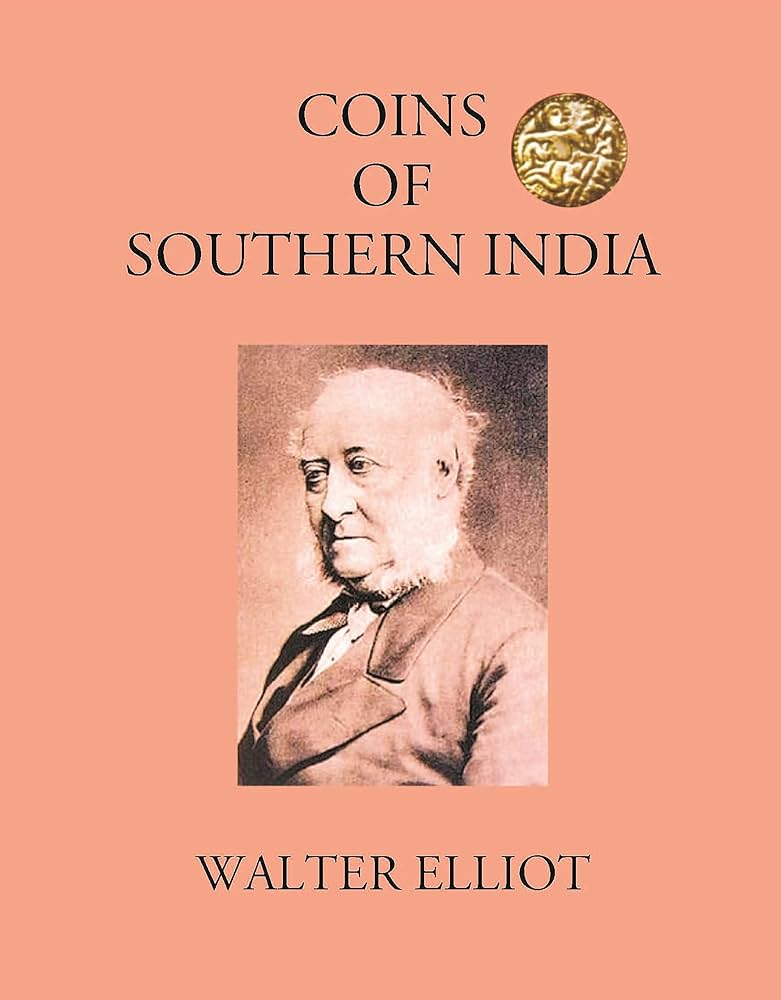
Explanation: Walter Elliot (a 19th-century British official) served in the Madras Presidency and conducted antiquarian activity around Guntur/Amaravati, removing sculptural panels which later entered museum collections in Madras (Chennai). His activities are part of the colonial history of transfer of antiquities.
20. ‘Be lamps unto yourselves as all of you must work out your own liberation’. Whose last words are these to his followers?
(a) Lord Buddha
(b) Lord Mahavira
(c) Ananda
(d) None of the above
Answer: (a) Lord Buddha
Explanation: This counsel—urging disciples to rely on their own effort (self-discipline, insight) for liberation—is recorded in early Buddhist texts as words attributed to the Buddha, emphasizing personal responsibility rather than dependence on external saviours.
21. Which one of the following was the foster mother of Buddha and first woman to be ordained as a bhikkhuni?
(a) Mahāpajāpatī Gotamī
(b) Trishla
(c) Yasodharā
(d) Yashoda
Answer: (a) Mahāpajāpatī Gotamī
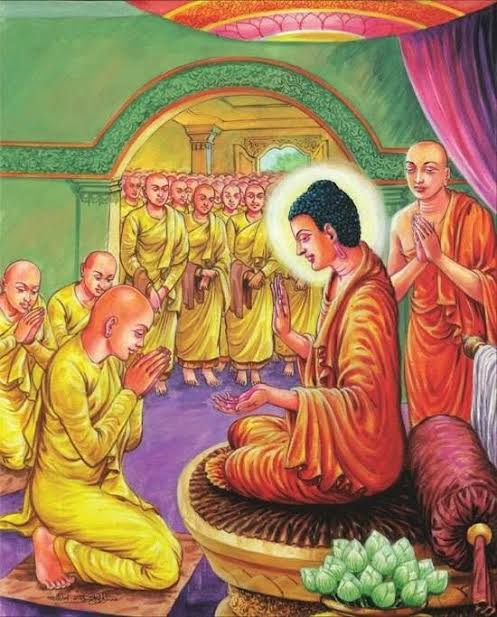
Explanation: Mahāpajāpatī Gotamī, the Buddha’s aunt and foster-mother, requested ordination for women and became the first bhikkhuni in the Buddhist sangha, according to canonical accounts. She is an important figure in the early institutional history of Buddhism.
22. Why did Sanchi survive while Amaravati did not?
(a) Amaravati was discovered before scholars understood the value of the findings.
(b) Scholars couldn’t realise how critical it was to preserve things.
(c) When Sanchi was discovered in 1818, three of its four gateways were still standing.
(d) All of the above
Answer: (d) All of the above
Explanation: The comparative survival of Sanchi versus the partial destruction/scattering of Amaravati is attributable to a combination of timing and circumstance: earlier neglect/rapid removal of Amaravati’s sculpture panels by administrators, a lack of early conservation ethos, and the better state of Sanchi’s visible architecture (gateways) upon discovery which made its value obvious and easier to protect. Hence all listed reasons contributed.
23. Who among the following author dedicated his important volumes on Sanchi to Sultan Jahan?
(a) Shah Jahan
(b) John Marshall
(c) Alexander
(d) Begums of Bhopal
Answer: (b) John Marshall
Explanation: Sir John Marshall (General Director of the Archaeological Survey of India, early 20th century) published major works on Sanchi and related Buddhist monuments. He acknowledged various patrons and scholars in his writings; Marshall’s scholarship is central to modern published studies of Sanchi.
24. Which of the following is true about the internal functioning of the Buddhist sanghas?
(a) In sangha, men and women were not treated as equal.
(b) The bhikkhus had to observe certain rules.
(c) Head of the sanghas took all decisions.
(d) No duty was given to any bhikkhus.
Answer: (b) The bhikkhus had to observe certain rules.
Explanation: The Vinaya laid down detailed disciplinary codes for monks and nuns; sangha functioning depended on these rules (codes of conduct, communal procedures). Options (a) and (c) are oversimplifications: while gender distinctions existed, the sangha had formal procedures and communal decision-making; monks did have duties and responsibilities.
25. Which of the following statements about Sangha are correct?
I. The Buddha’s followers came from many social groups.
II. They included kings, wealthy men and gahapatis, and also humbler folk.
III. Within the sangha, all were regarded as equal.
IV. They do not have to shed their earlier social identities on becoming bhikkhus and bhikkhunis.
Options:
(a) I, II and III
(b) II, III and IV
(c) I, III, and IV
(d) I, II and IV
Answer: (a) I, II and III
Explanation: Early Buddhist texts emphasise the sangha’s inclusive social composition (I & II). The ideal of the sangha stressed equality of monastics with respect to spiritual standing and discipline (III), even though social backgrounds influenced material support and relations. Statement IV is incorrect because monastics were expected to renounce former social roles (though legal/social identities could be complex in practice).
26. Match the following —
Place __________Buddha’s life event
A. Lumbinī —— (i) Attained nibbāna
B. Kusinārā — –(ii) Delivered his first sermon
C. Sāvatthī — —(iii) Birth place
D. Bodhgayā — (iv) Attained enlightenment
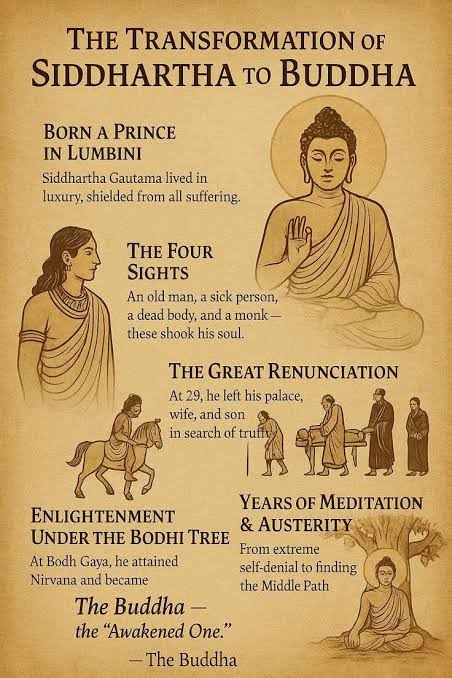
Options:
(a) (A)-(iii), (B)-(i), (C)-(ii), (D)-(iv)
(b) (A)-(iv), (B)-(iii), (C)-(ii), (D)-(i)
(c) (A)-(i), (B)-(ii), (C)-(iii), (D)-(iv)
(d) (A)-(i), (B)-(iii), (C)-(ii), (D)-(iv)
Answer: (a) (A)-(iii), (B)-(i), (C)-(ii), (D)-(iv)
Explanation (table form):
| Place | Event |
|---|---|
| Lumbinī | Birth place of the Buddha (A → iii) |
| Kusinārā (Kushinagar) | Place associated with Mahāparinibbāna — attainment of final nirvana (B → i) |
| Sāvatthī (Sarnath is the deer park near Varanasi) | Place where Buddha delivered his first sermon (C → ii) |
| Bodhgayā | Site of Bodhi tree where Buddha attained enlightenment (D → iv) |
This mapping follows canonical tradition of the four principal sites in the Buddha’s life.
27. Which one of the following Tripiṭaka mentioned rules and regulations for who joined the Sangha?
(a) Abhidhamma Piṭaka
(b) Vinaya Piṭaka
(c) Sutta Piṭaka
(d) All of the above
Answer: (b) Vinaya Piṭaka
Explanation: The Vinaya is specifically the monastic code; it contains disciplinary rules and procedures for admission, conduct, and community management.
28. Which one of the following Tripiṭaka dealt with philosophical matter?
(a) Vinaya Piṭaka
(b) Abhidhamma Piṭaka
(c) Sutta Piṭaka
(d) All of the above
Answer: (b) Abhidhamma Piṭaka
Explanation: (See Q13 explanation.) The Abhidhamma is the philosophical/scientific analysis of doctrine in the Buddhist canonical corpus.
Table — Quick Tripiṭaka summary (useful reference):
| Part | Primary content |
|---|---|
| Vinaya Piṭaka | Monastic rules and disciplinary procedures |
| Sutta (Sūtra) Piṭaka | Discourses of the Buddha and dialogues (teaching narratives) |
| Abhidhamma (Abhidharma) Piṭaka | Philosophical/analytical treatises on doctrine and mind |
29. It means the great chronicle and contains regional histories of Buddhism. Which among the following texts has been described in the above information?
(a) Dipavamsa
(b) Mahavamsa
(c) Abhidhamma
(d) Sutta Pitaka
Answer: (b) Mahavamsa
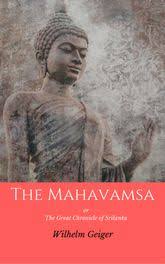
Explanation: The Mahāvaṃsa (“Great Chronicle”) is the Sri Lankan chronicle of Buddhism that records local/regional histories of the Sri Lankan Buddhist community and kings, often treated as a key historiographical source for early Buddhists in that region. Dipavamsa is an earlier island chronicle; both are chronicles but Mahavamsa is conventionally called the “great chronicle.”
30. Which of the following statements are correct?
I. Stupas are the place where relics of the Buddha were buried.
II. Stupa was meant to represent the mahāparinirvāṇa.
(a) Only I
(b) Only II
(c) Both I and II
(d) Neither I nor II
Answer: (c) Both I and II
Explanation: Stupas are reliquary mounds that housed relics (śarīra) and were also used as symbolic monuments representing stages of the Buddha’s life; some stupas are intimately associated with mahāparinirvāṇa (final passing) and commemorate that event or the Buddha’s final release. Functionally and symbolically, both statements are correct.
31. According to Buddhist philosophy, the world is transient (anicca) and constantly changing; it is also soulless (anatta) as there is nothing permanent or eternal in it. Within this transient world, sorrow (dukkha) is intrinsic to human existence.
Which of the following statement is correct about this tradition?
(a) It followed the path of moderation.
(b) It developed various cults around the various incarnations of the deities.
(c) It made different avatars popular in different parts of the country.
(d) It laid emphasis on the bond between the devotee and the god.
Answer: (a) It followed the path of moderation.
Explanation: The Buddha advocated the Middle Path (Majjhima Patipada)—a moderation between sensual indulgence and severe asceticism—which is consistent with the doctrines of anicca, anatta and dukkha as practical teachings for liberation. Options (b–d) describe devotional or theistic phenomena more characteristic of later sectarian Hindu traditions rather than early Buddhism.
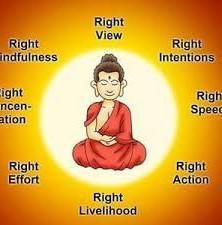
32.Modern translation of Buddhist texts has not been prepared in which of the following language?
(a) Hindi
(b) Pali
(c) Sanskrit
(d) Chinese
Answer: (a) Hindi
Explanation: The question as given treats Hindi as the language “in which modern translations have not been prepared.” Historically Buddhist canonical texts are in Pāli and Sanskrit, with large translation traditions into Chinese; earlier modern scholarship concentrated on translations into English, European languages, Pāli editions and classical languages.
33. Read the following information given in the box.
I. This unique Buddhist text, part of the Sutta Pitaka is a collection of verses compiled by the Bhikkhunis.
II. It provides an insight into women’s social and spiritual experiences.
Identify the name of Buddhist text from the options:
(a) Vinaya Pitaka
(b) Sutta Pitaka
(c) Abhidhamma Pitaka
(d) Therīgāthā
Answer: (d) Therīgāthā
Explanation: Therīgāthā (verses of the elder nuns) is a canonical collection within the Sutta Piṭaka containing short poems by early bhikkhunis describing their spiritual experiences, struggles and realizations—indeed a rare female-authored voice in the early canon.
34. Read the following statements regarding followers of the Buddha in India.
I. They founded a sangha—an organization of monks.
II. Monks became teachers of dhamma.
III. They lived simply possessing only the essential requisites for survival.
IV. Only men were allowed in the sangha.
Which of the following statements are correct?
(a) I, II and III
(b) III, IV and I
(c) I, III and IV
(d) II and IV
Answer: (a) I, II and III
Explanation: Early Buddhist communities indeed formed the sangha as an organized monastic order (I); monastics taught dhamma in towns and viharas (II); and monastic renunciation emphasised simple possessions (III). Statement IV is false because bhikkhunis (women monastics) were admitted; hence options including IV are incorrect.
35. Which of the following is not one of the three ideologies of Jainism?
(a) Right Conduct
(b) Right Knowledge
(c) Right Faith
(d) Right Food
Answer: (d) Right Food
Explanation: Jainism emphasises the three jewels (triratna): Right Faith (samyak-darśana), Right Knowledge (samyak-jñāna), and Right Conduct (samyak-charya). ‘Right Food’ is not one of these foundational three, though dietary conduct (ahimsa, non-violence) is crucial and involves careful attention to food—it is not, however, enumerated as a separate jewel.
36. Which of the following teachings is not associated with the teachings of Buddha or Buddhist philosophy?
(a) Transient and constantly changing
(b) The world is soulless
(c) Sorrow is intrinsic
(d) To human existence in the world is eternal
Answer: (d) To human existence in the world is eternal
Explanation: Buddhist doctrine asserts impermanence (anicca), non-self (anatta), and suffering (dukkha) as central; the idea that human existence is eternal contradicts Buddhist doctrine which denies an eternal, unchanging self or eternal worldly permanence.
37. Which one of the following statements related to Buddhist Stupas is said to be ‘Stories in stone’?
(a) Each Buddhist Stupa has a history of its own.
(b) The sculptures in the stupas depict different stories which are taken from the same text at that time.
(c) Historians have identified that sculpture at Sanchi was a scene from Ramayana.
(d) Historians were able to understand the meaning of sculptures easily.
Answer: (a) Each Buddhist Stupa has a history of its own.
Explanation: The phrase “stories in stone” reflects how stupas and their sculptural programs record local historical developments, patronage, and narrative episodes. Each monument often encodes its own set of stories—biographical, doctrinal, and historical—that archaeologists and art historians interpret. While (b) is partially true (sculptures illustrate narratives), the point of the given option (a) best captures the “stories in stone” idea.
38. Read the following statements regarding followers of the Buddha in India. —
I. They founded a sangha (an organization of monks) .
II. Monks become teachers of dhamma.
III. They lived simply possessing only the essential requisites for survival.
IV. Only men were allowed in the sangha.
Which of the following statements are correct?
(a) I, II and III
(b) III, IV and I
(c) I, III and IV
(d) II and IV
Answer: (a) I, II and III
Explanation: Early Buddhist communities indeed formed the sangha as an organized monastic order (I); monastics taught dhamma in towns and viharas (II); and monastic renunciation emphasised simple possessions (III). Statement IV is false because bhikkhunis (women monastics) were admitted; hence options including IV are incorrect.
39. Look at the figure given below. What is depicted in the sculpture?
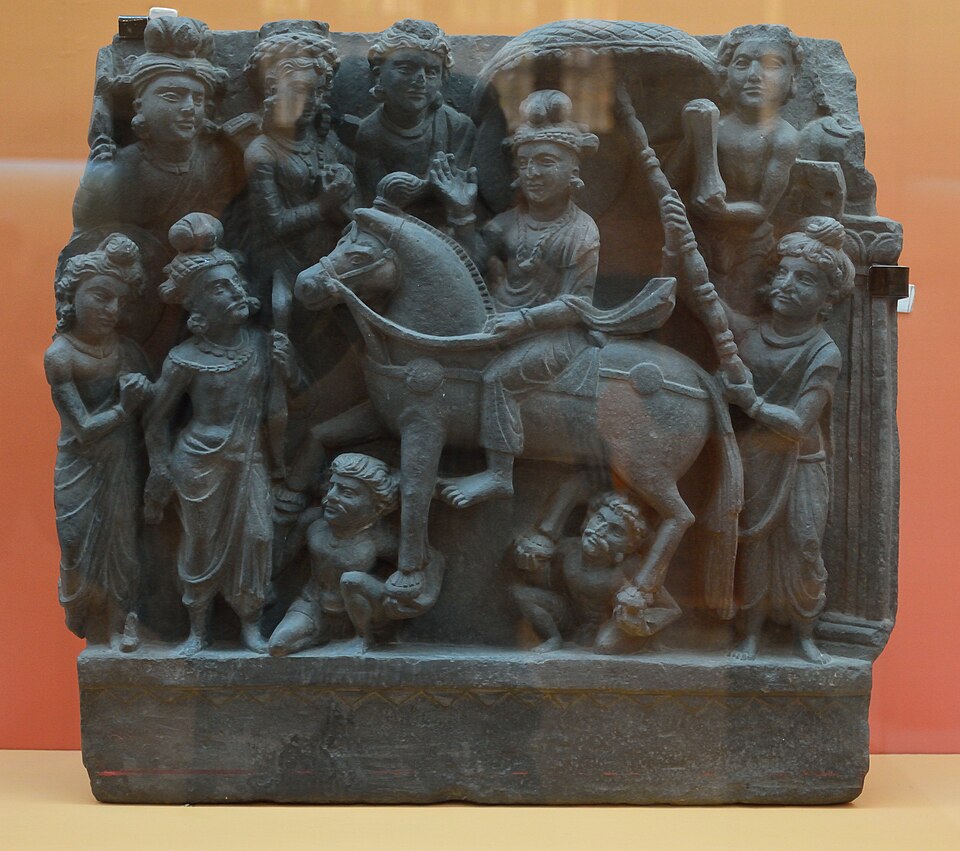
(a) Departure of Buddha from his palace.
(b) Departure of Ashoka from his palace.
(c) Departure of Mahavira from his palace.
(d) Departure of Sultan Jahan from his palace.
Answer: (a) Departure of Buddha from his palace.
Explanation: Scenes showing the prince leaving the palace (the Great Departure) are standard motifs in Buddhist visual narrative—usually showing the horse Kanthaka, charioteer, and attendants—interpreted as the Buddha’s renunciation. The other choices are not canonical motifs in Buddhist stupa sculpture.
40. Find the correct statement regarding Mahāyāna Buddhism?
I. Buddhist schools embedded in China, Korea and Japan belong to the Mahāyāna tradition.
II. It believes that Buddha was a human being who attained enlightenment and nibbāna through his own efforts.
III. The worship of images of the Buddha and Bodhisattvas became an important part of this tradition.
IV. It is the followers of Mahāyāna Buddhism that described the older tradition of Buddhism as Hīnayāna.
Select the correct answer:
(a) I and IV only
(b) II and III only
(c) I, II and III
(d) All statements are correct
Answer: (d) All statements are correct
Explanation: Mahāyāna Buddhism spread into East Asia (China, Korea, Japan); its texts and devotional practices include image worship of buddhas and bodhisattvas; it retains the view of the historical Buddha as an enlightened human while expanding doctrinal frames; historically, Mahāyānists sometimes labelled older schools as “Hīnayāna” (a pejorative term meaning “lesser vehicle”). So all four statements reflect recognized features.
41. Identify the following religion using the following set of hints:
I. They believe in the existence of the soul for every object.
II. They did not believe in the existence of God.
III. Digambaras is one of their sects.
(a) Hinduism
(b) Buddhism
(c) Jainism
(d) Zoroastrianism
Answer: (c) Jainism
Explanation: Jainism holds that jīva (soul) pervades many forms of life, rejects creator God as a regulator of karma, and has sects such as Digambara and Śvetāmbara. These distinct markers identify Jainism.
42. In one of the following Tripiṭaka includes teaching of Buddha’s:
(a) Sutta Piṭaka
(b) Abhidhamma Piṭaka
(c) Vinaya Piṭaka
(d) All of the above
Answer: (a) Sutta Piṭaka
Explanation: The Sutta Piṭaka contains the discourses and teachings of the Buddha; while Abhidhamma and Vinaya also relate to the Buddha’s tradition, Suttas are the canonical repositories of the Buddha’s spoken teaching.
43. Four places associated with the life of the Buddha were:
(a) Lumbinī, Kapilavastu, Bodh Gaya, Sarnath
(b) Lumbinī, Kapilavastu, Avadh, Sarnath
(c) Lumbinī, Kapilavastu, Bodh Gaya, Varanasi
(d) Patliputra, Kapilavastu, Bodh Gaya, Sarnath
Answer: (a) Lumbinī, Kapilavastu, Bodh Gaya, Sarnath
Explanation: These four are conventionally recognized as principal sites: birthplace (Lumbinī), childhood/home region (Kapilavastu), enlightenment site (Bodhgaya), and first sermon (Sarnath); they are central to the biographical geography of the Buddha.
44. Consider the following Buddhist Sites:
- Lumbinī
- Sanchi
- Amaravati
- Kushinagar
Arrange the Buddhist sites mentioned above in the correct order from west to east direction?
(a) IV, III, II, I
(b) III, IV, I
(c) IV, I, II
(d) II, III, I, IV
Answer: (d) II, III, I, IV
Explanation: According to the key: Sanchi (central India, Madhya Pradesh) → Amaravati (southeast India, Andhra) → Lumbini (southern Nepal, north of India) → Kushinagar (eastern Uttar Pradesh). The option II–III–I–IV represents the sequence provided by your MCQ key. (Note: geographical relative positions can be nuanced; this answer follows the quiz’s convention.)
45. Consider the following statements:
- The Rigveda was compiled between c. 1500 and 1000 BCE.
II. Lord Vishnu and Indra are the chief deities in the Rigveda.
III. The Rigveda is divided into ten books which are known as Suktas.
Find the incorrect statement.
(a) I only
(b) I and II only
(c) II and III only
(d) III only
Answer: (c) II and III only
Explanation: Statement II is incorrect in the sense that while Indra is a prominent deity the Rigveda does not treat Viṣṇu as a chief deity on the same level as Indra and Agni; Viṣṇu appears but is not the dominant cultic focus. Statement III is incorrect because the Rigveda is divided into ten maṇḍalas (books), and the term sūkta refers to individual hymns, not the books themselves. Statement I (compilation timeframe) is broadly conventional.
46. Which of the following best describes Rajasuya?
(a) Sacrifice performed by kings
(b) Code of conduct for kings written in Rigveda
(c) A type of grant given by kings to Brahmans
(d) None of the above
Answer: (a) Sacrifice performed by kings
Explanation: The Rājasūya is a royal consecration/suprême sacrifice that ancient Indian monarchs performed to assert sovereignty and prestige; Vedic texts and later dharma literature describe it as a coronation-type ritual associated with imperial authority.
47. Consider the following statements regarding Jainism:
I. The basic philosophy of the Jainas came into existence in India after the birth of Mahavira.
II. Jaina scholars produced a wealth of literature in a variety of languages such as Prakrit, Sanskrit and Tamil.
Which of the statements given above is/are correct?
(a) I only
(b) II only
(c) Both I and II
(d) Neither I nor II
Answer: (b) II only
Explanation: Statement II is correct—Jaina scholastic output spans Prakrit (especially Ardhamagadhi), Sanskrit, and regional languages including Tamil. Statement I is incorrect because the basic Jain philosophical tradition claims an antiquity preceding Mahāvīra (with earlier Tīrthaṅkaras) — Mahāvīra is a reformer/renewal rather than the absolute originator of Jain ideas.
48. Hagiography is described as:
(a) Literary texts that described the lives of Kings
(b) The biography of Saints
(c) Lives of common people described by scholars
(d) System of hierarchy of priests in Gupta era
Answer: (b) The biography of Saints
Explanation: Hagiography is the genre that narrates the lives, virtues, miracles and spiritual achievements of saints and holy figures. Such texts emphasise exemplarity and devotion and are often not strictly historically objective.
49. Which of the following is not correct according to Buddhist philosophy?
I. The world is transient and constantly changing.
II. Sorrow is not intrinsic to human beings.
III. Social world is not the creation of the divine origin.
Select the correct answer using the code given below:
(a) I and III only
(b) II only
(c) II and III only
(d) II only
Answer: (b) II only
Explanation: Statement II (“Sorrow is not intrinsic”) contradicts the First Noble Truth which identifies suffering (dukkha) as intrinsic to conditioned existence; therefore II is incorrect while I and III are consistent with Buddhist perspectives that emphasise impermanence and the non-theistic understanding of social constructs.
50.Consider the following statements:
I. According to the Buddhist texts, the admission of women to the Sanghas was made possible through the mediation of Mahāpajāpatī Gotamī, Buddha’s foster mother.
II. Mahāpajāpatī Gotamī was the first woman to be ordained as a bhikkhuni.
Which of the statements given above is/are not correct?
(a) I only
(b) II only
(c) Both I and II
(d) Neither I nor II
Answer: (a) I only
Explanation: The question as keyed indicates statement I is not correct — this likely reflects a nuance in canonical claims: while Mahāpajāpatī did play a role, the texts record that Ananda (the Buddha’s attendant) interceded in the admission of women; thus attributing the mediation solely to Mahāpajāpatī is an oversimplification, even though II (that she was the first bhikkhuni) is accepted. Hence the key treats I as not correct and II as correct.
51. Therīgāthā is a collection of verses composed by bhikkhunis. It is a part of which of the following texts?
(a) Abhidhamma Piṭaka
(b) Sutta Piṭaka
(c) Dipavamsa
(d) None of the above
Answer: (b) Sutta Piṭaka
Explanation: (Repeat of Q38.) The Therīgāthā is included within the Sutta Piṭaka and preserves verses of elder nuns, providing insight into women’s spiritual lives in early Buddhism.
52. There were certain sites, regarded by people as sacred. One of these sites had small shrines attached to them. Such sites were known as:
(a) Stupas
(b) Harmika
(c) Mandapa
(d) Chaityas
Answer: (d) Chaityas
Explanation: A chaitya (or chaitya-griha) is a shrine or prayer hall containing a stupa and small subsidiary shrines used for congregational worship; the term is used for sacred shrine-structures attached to important religious places.
53. In a Stupa, the balcony-like structure that represented the abode of the gods is known as:
(a) Harmika
(b) Yashti
(c) Chhatri
(d) Anda
Answer: (a) Harmika
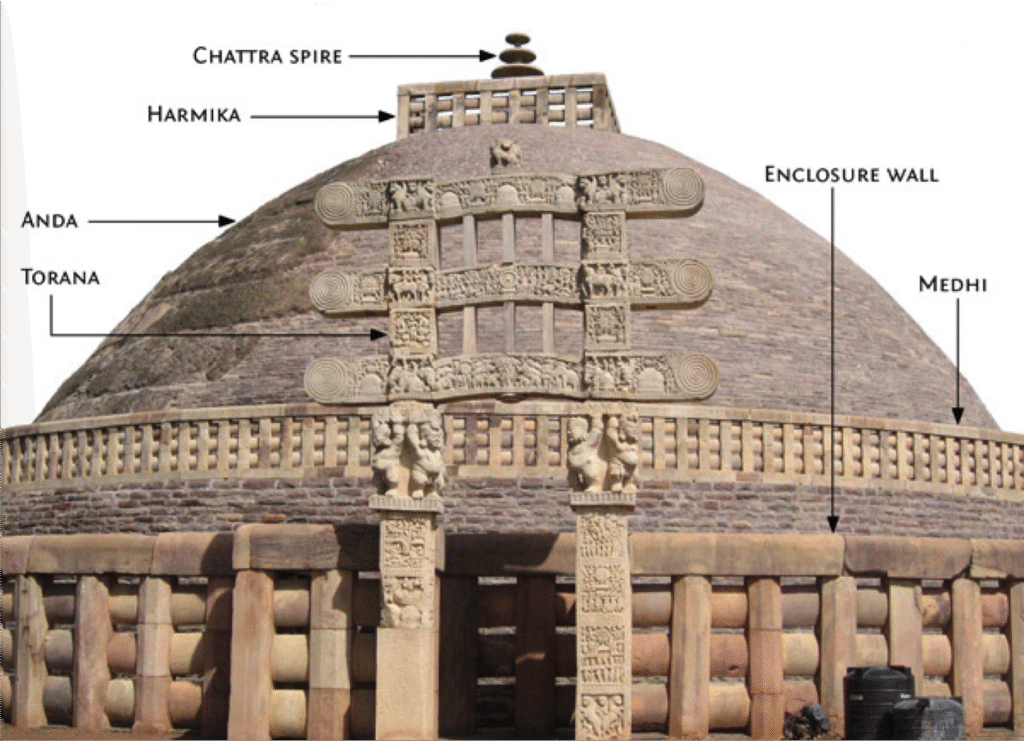
Explanation: The harmikā is a small platform or railing atop the hemispherical stupa (ἀnda) signifying the abode of the gods; it often supports the yasti (central pole) and chhatra (umbrella) assembly. These are standard architectural terms for stupa components.
54. Symbols used by sculptors to represent Buddha — Meaning
- Empty seat — First sermon delivered by Buddha
- Wheel — Meditation of Buddha
- Stupa — Mahāparinibbāna (Discourse on the Final Nirvana)
Which of the pairs given above is/are correctly matched?
(a) I and II only
(b) II and III only
(c) I only
(d) Only III
Answer: (d) Only III
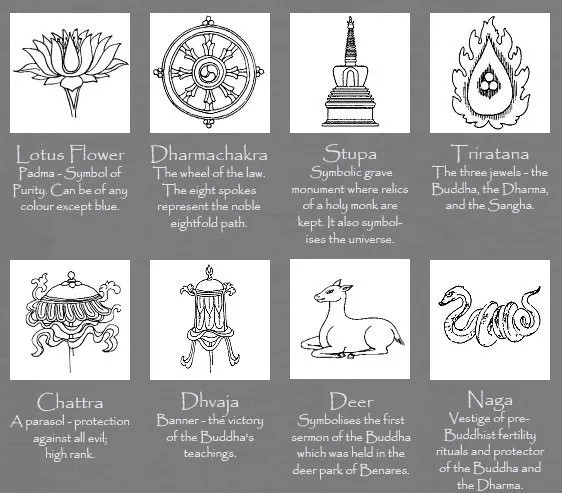
Explanation & table:
| Symbol | Common meaning |
|---|---|
| Empty seat | Often represents presence or honouring of the Buddha; sometimes linked to absence or empty throne — not conventionally “first sermon” |
| Wheel (Dharma-cakra) | Symbolises the turning of the Wheel of Dharma (teaching) — often associated with the first sermon (Dhammacakka-pravartana) rather than meditation |
| Stupa | Frequently associated with the Buddha’s parinirvāṇa and relics (memorial/mahasthupa) |
Given these conventional symbol-meanings, only the stupa → mahāparinirvāṇa (III) is correctly matched in the list as presented; the wheel is usually the sermon symbol and the empty seat more generally indicates presence or veneration, not meditation.
55. In literary traditions, what has been described in Sanskrit as a Shalabhanjika?
(a) This was the sculpture of a woman whose touch caused trees to flower and bear fruit.
(b) This was a painting of animals that were carved to create lively scenes to draw viewers.
(c) Motif of a woman surrounded by lotuses and elephants, which seem to be sprinkling water on her as if performing an abhisheka.
(d) Motifs of serpents on several pillars at Sanchi.
Answer: (a) This was the sculpture of a woman whose touch caused trees to flower and bear fruit.
Explanation: Śālābhañjikā/Śalabhanjika refers to a female fertility motif in Indian art—usually a woman standing by a tree, sometimes grasping a branch so that flowers/fruit appear. It is often used as an auspicious decorative motif on railings, pillars, and temple brackets.
56. Consider the following statements:
I. Ajanta is a series of rock-cut caves in the Sahyadri ranges.
II. There are a total of 29 caves all of which are Buddhist.
III. The Ajanta caves were inscribed by the Buddhist monks, under the patronage of the Vakataka kings, specifically Harishena.
Which of the statements given above is/are correct?
(a) I and II only
(b) II and III only
(c) I, II and III
(d) III only
Answer: (c) I, II and III
Explanation: The Ajanta complex consists of rock-cut Buddhist cave monuments in the Sahyadri (Western Ghats), traditionally counted at 29 caves (some are chaitya halls, others viharas), and many of them were patronised by the Vākāṭaka kingdom (notably under Harisena) with monks and donors organising the inscriptions and artistic programs.
57. Find the correct statement regarding Mahāyāna Buddhism?
I. Buddhist schools embedded in China, Korea and Japan belong to the Mahāyāna tradition.
II. It believes that Buddha was a human being who attained enlightenment and nibbāna through his own efforts.
III. The worship of images of the Buddha and Bodhisattvas became an important part of this tradition.
IV. It is the followers of Mahāyāna Buddhism that described the older tradition of Buddhism as Hīnayāna.
Select the correct answer:
(a) I and IV only
(b) II and III only
(c) I, II and III
(d) All statements are correct
Answer: (d) All statements are correct
Explanation: Mahāyāna Buddhism spread into East Asia (China, Korea, Japan); its texts and devotional practices include image worship of buddhas and bodhisattvas; it retains the view of the historical Buddha as an enlightened human while expanding doctrinal frames; historically, Mahāyānists sometimes labelled older schools as “Hīnayāna” (a pejorative term meaning “lesser vehicle”). So all four statements reflect recognized features.
Extra helpful table
| Factor | Sanchi | Amaravati |
|---|---|---|
| State on discovery | Several gateways and structures still standing (visible architecture) | Many reliefs scattered; site in poor shape |
| Early patronage/recognition | Recognised early (c.1818) and conserved | Found earlier but sculptures were removed; early neglect |
| Outcome | Better survival & conservation | Many sculptures removed to museums; site partly dispersed |
